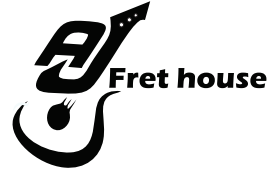
D# Guitar Chord:
- 1st Finger (Index): Barre all three strings (D, G, and B) on the 3rd fret with your index finger.
- 2nd Finger (Middle): Place your middle finger on the 4th fret of the B string (2nd string).
- 3rd Finger (Ring): Place your ring finger on the 5th fret of the D string (4th string).
- 4th Finger (Little/Pinky): Place your little finger on the 6th fret of the A string (5th string).
Strumming Instructions:
- Strum all the strings except the 6th string (low E). This ensures that the chord rings out clearly without the low E string interfering.

D# Guitar Chord:
- 1st Finger (Index): Barre all five strings from the 5th string (A string) to the 1st string (high E) on the 6th fret.
- 2nd Finger (Middle): Place your middle finger on the 8th fret of the D string (4th string).
- 3rd Finger (Ring): Place your ring finger on the 8th fret of the G string (3rd string).
- 4th Finger (Little/Pinky): Place your little finger on the 8th fret of the B string (2nd string).
Strumming Instructions:
- Strum all the strings except the 6th string (low E). This allows the chord to ring out cleanly, focusing on the higher strings.
Here are some practical tips for mastering the D# chord on guitar:
1. Master the Barre:
- The D# chord requires a barre on the 6th fret across five strings. Ensure your index finger is pressing down firmly and evenly across the strings to avoid muted notes.
- If you’re struggling with the barre, focus on finger strength exercises to gradually build up the necessary pressure.
2. Finger Positioning:
- Keep your middle, ring, and pinky fingers curved and apply firm pressure on the 8th fret for the D, G, and B strings.
- Position your fingers close to the frets to reduce buzzing or muting.
3. Thumb Placement:
- Place your thumb behind the neck of the guitar, around the middle, to provide the necessary support for the barre and to reduce strain on your hand.
4. Mute the 6th String:
- Avoid strumming the 6th string (low E). You can gently touch the 6th string with your index finger to mute it, ensuring it doesn’t ring out.
5. Start Slow and Build Speed:
- Start by playing the D# chord slowly to ensure clarity in each string. Gradually build speed as you get more comfortable with the shape.
6. Use It in Chord Progressions:
- Practice transitioning to and from the D# chord within common chord progressions. For example, practice moving between G#, C minor, and D#.
7. Barre Practice:
- To improve your barre chord technique, practice different barre chords like F or G#. This will help you build confidence and flexibility in your playing.
These tips will help you build strength and accuracy in playing the D# chord, enhancing your overall guitar skills.
